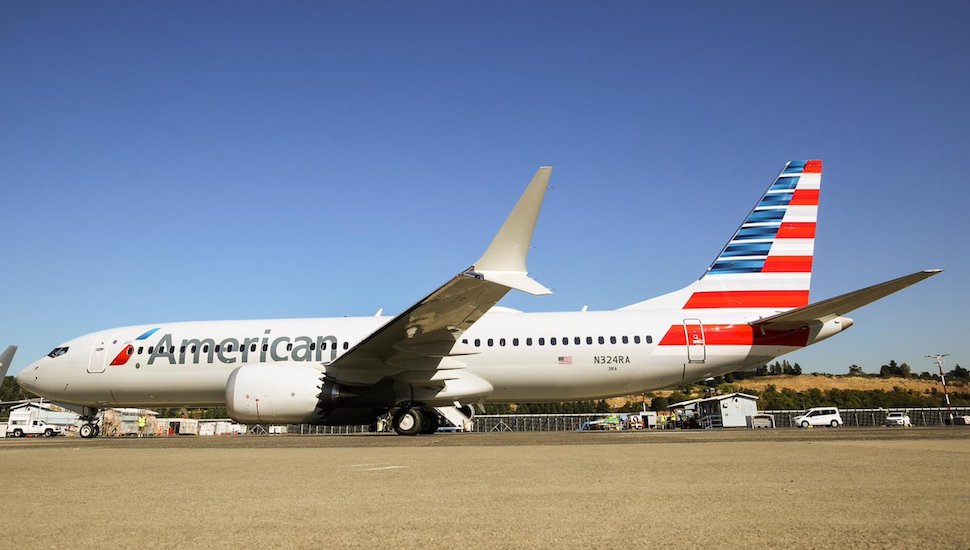US carriers are increasingly bearish on returning the Boeing 737 Max to the skies, with American Airlines and United Airlines joining Southwest Airlines removing the type from summer schedules.
Both American and Dallas-based Southwest - the two largest US operators - have removed the 737 Max 8 from their schedules through August in an effort to provide passengers with a more reliable operation. Chicago-based United, with the smallest US fleet of 737 Max aircraft, has removed the aircraft through July.
"By extending our cancellations through the summer, we can plan more reliably for the peak travel season," say American chief executive Doug Parker and president Robert Isom in a letter to employees and passengers on 14 April.
The Fort Worth, Texas-based carrier has removed the 737-8 from schedules through 19 August, more than two months later than its previous 5 June date. It will cancel roughly 115 flights – 1.5% of its system total – daily from June to August as a result.
American has been cancelling roughly 90 flights a day since the 737 Max was grounded in March.

American
US carriers were initially bullish on when the 737 Max would return to service. American first removed it through 24 April, while Southwest removed it through 20 April. However, carriers elsewhere took a much more conservative approach to the grounding, with Air Canada immediately removing the type through July.
Southwest, which operated 34 737-8s when the type was grounded on 14 March, said on 12 April that it had removed the aircraft from schedules through 1 August.
American operated 24 737-8s when the type was grounded. It was scheduled to take delivery of 16 more aircraft this year, Cirium's Fleets Analyzer shows.
The carrier reduced its total unit revenue growth forecast by one percentage point to flat to up 1% in the first quarter as a result of the 737 Max groundings and other cancellations.
United has 14 737 Max 9s grounded, and says it has been able to cover the impacted flights with other aircraft in its fleet. However, the airline says this is "harder" during the peak summer season thus the decision to remove the type from schedules.
"We’ll continue to take extraordinary steps to protect our customers’ travel plans," says United. "Moving forward, we’ll continue to monitor the regulatory process and nimbly make the necessary adjustments to our operation and our schedule to benefit our customers."
United had planned to take delivery of 13 737-9s this year.
It is unclear when the 737 Max will return to the skies. Since global aviation regulators and airlines grounded the type following the fatal crash of an Ethiopian Airlines 737-8 on 10 March, Boeing has worked towards addressing issues with the aircraft's flight control software, particularly the manoeuvring characteristics augmentation system (MCAS).
However, after the airframer unveiled an update to airlines and reporters at the end of March, the US Federal Aviation Administration said on 1 April additional work by Boeing was "needed" and that they planned to begin reviewing the update in the coming weeks.
Wall Street analysts are increasingly pessimistic on when the 737 Max will begin flying again. JP Morgan analysts expect that to happen in September, while other analysts have said it will not occur before mid-summer.
"We expect the Max will return to service in the US before it returns to service elsewhere in the world given that most regulators want to put the aircraft through their own approval process," says Helane Becker, an analyst at Cowen, in a report today.
If the FAA recertifies the 737 Max during the summer peak, Parker and Isom say the aircraft will return at American as "spares to supplement our operation".
Miami was the centre of American's 737-8 operation prior to the grounding. Nearly half of all its flights on the type originated at the South Florida airport in March, Cirium schedule data shows. New York LaGuardia had the second highest concentration of Max flights.
The airline continues to forecast roughly 3% capacity growth in 2019, driven largely by its plan to add more than 100 flights a day at its Dallas/Fort Worth base. Much of the balance of its growth is expected to come from a shift to larger gauge aircraft elsewhere, including the 196-seat Airbus A321neo that it introduced in Phoenix earlier in April.
American will report its first quarter earnings on 26 April, and United on 17 April. Both are expected to comment on the 737 Max grounding.
Updated with comments from United.
Source: Cirium Dashboard






















